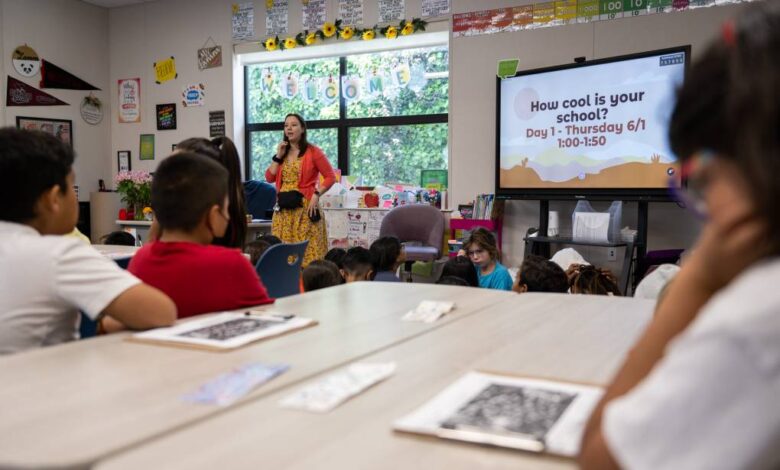The climate change lesson plans teachers need and don’t have

New York state is currently considering several climate education bills. If the proposed policies become law, the state will join California and New Jersey in mandating that climate topics be introduced across grade levels and subjects, not just confined to science class. A wide range of science and environmental groups such as the National Wildlife Federation and Earthday.org back this interdisciplinary approach to climate education.
But as the movement for teaching climate grows, thanks to new standards and increasing student curiosity, teachers are on the hunt for materials and lessons they can rely on. “I think there’s a big disconnect,” said Lauren Madden, professor of elementary science education at The College of New Jersey. “Teachers really need materials that they can use tomorrow.”
For the last few years, Madden has been researching the experiences of teachers who are tackling this topic. She shared some of her results with The Hechinger Report. SubjectToClimate, a large free repository of climate change lessons, also shared some data on its most popular lessons and materials.
Madden said that what teachers need most are clear strategies that allow them to plug climate lessons into existing curricula, so that climate can be interwoven with existing requirements, rather than wedged into an already-packed schedule. “Teachers want and need straightforward starting points in terms of instructional materials,” she said.
Yen-Yen Chiu, director of content creation for SubjectToClimate, agreed. In response to demand, she said, the organization is beginning to create teacher pacing guides, like a middle school math pacing guide that maps specific climate resources from their database to math standards.
Here’s an overview of more key findings from Madden, and from Hammack and Chiu at SubjectToClimate.
- Younger learners have big questions: At SubjectToClimate, the most-searched lessons are for grades K-5; and there is unmet demand for grades 3-5. Hammack said it can be tough to find materials that are simple enough for the youngest students. “I created a unit on energy — I intended it for K-2 but we ended up changing it to 3-4,” she said. “Energy is so abstract for a K-2nd audience.”
- Energy, extreme weather and humanities: Energy is the most popular topic on SubjectToClimate. There’s also growing interest in lessons related to extreme weather, and lessons that relate to non-science subjects, such as writing and public speaking. One art lesson related to energy is among the top 10 most popular on the site.
- Facts and evidence: Madden finds teachers (especially new ones) want to gain familiarity with facts they might not have learned in a general education curriculum. They also need to be able to clearly and simply attribute scientific findings to specific data: i.e., how we know that atmospheric carbon is rising or that storms are getting bigger. This presents a bigger challenge, requiring the development of scientific literacy, Madden said: “I think it’s important that we explain what counts as evidence.”
- Debate, but not doubt: In the United States, climate change is still a highly politicized topic. Teachers need help to present debates in an evolving field of research without losing sight of the overwhelming scientific consensus. This also includes lessons that directly combat misinformation or disinformation that students might bring in from outside the classroom. “Teachers want to know where scientific debate is appropriate. For example, wind vs. solar is a topic that can yield productive discussion, while whether climate change is exacerbated by human activity is not,” said Madden. The New York Times recently reported that a Republican state representative wants to amend standards in Connecticut in a way that would obscure that consensus in the name of open debate.
- Climate brings up feelings: While a lot of introduction of climate topics is happening in response to new state standards, Madden said students are also bringing up the topic, for example, in response to extreme or unseasonable weather. And that’s making some teachers nervous. “Teachers worry that they are not knowledgeable enough about the science of climate change to answer students’ questions appropriately,” she said. “There is also concern about inciting dread and anxiety in children, especially at the lower grade levels.” Hammack said that she finds herself wondering how deep to go: “Some of the videos I’ve been watching are scaring me and I’m 44!” And Madden said those climate emotions are, if anything, stronger among kids in higher grades. “In my experience, it’s preteens and teenagers who have that sense of understanding the scope of these problems,” she said. “They are very concerned.”
- English Language Learners: There’s a gap in resources for these learners. Madden points out that in Spanish, “clima” is the word for both “weather” and “climate,” which can at times cause confusion. SubjectToClimate lists 93 resources suitable for Spanish speakers and/or Spanish classes.
- Focus on solutions: Related to concerns about climate anxiety is a clear desire for lessons that deal with solutions. Among the SubjectToClimate top 10 most-trafficked lesson plans are two that deal with renewable energy, one about conservation, one about reducing, reusing and recycling, and one about green transportation. Underscoring the demand, This Is Planet Ed (where, full disclosure, I’m an advisor) and The Nature Conservancy are currently collaborating on an initiative to create more short-form content for children focused on hope and solutions.
“I have to say that the message that comes across loud and clear to me has been — telling the truth is really important, and focusing on areas for solutions and optimism,” said Madden. “There are really great things happening at the edges of what humans are capable of right now.”
Teacher-recommended climate change resources:



